A Traditional Experience
Sometimes I wish that I could create one word that would sum up an entire experience in all its glory, it would certainly save you and me a lot of time. Since I can’t (be bothered) maybe I should look into synonyms for ‘amazing’, because using unusual word order and juxtaposition can only go so far.
Before I went on this ‘homestay’ experience I was more than slightly apprehensive, no perhaps not ‘apprehensive’, more utterly cynical. I thought it was going to be a rope-hangingly painful, long drawn out affair, with too much polite conversation to handle, and I would have to feign tiredness to be allowed to retreat into the relative comfort of just me and my mind. Again my cynicism deserves to be shackled to a dark corner.
Within the first two minutes of the ‘experience’ beginning I was nearly in tears of laughter. My ‘mother’, Mrs Yoko Shimizu showed me the house that I would be staying in that night – it was two minutes walk from my flat. In fact it was so close the main object in view from the back garden was my block of flats. Anyway, we were driven to a hall somewhere close by for the weekends’ event – drawing and painting traditional Japanese Koinobori (koi-carp streamers and floats). The hall was full of foreign, sorry ‘international’, people – Mexicans, New Zealanders, a Russian, a Korean, an American, an Indonesian, and us Brits – this was to be expected; however, what was not expected at all, were the abundance of professional photographers and cameramen constantly invading personal space. We now knew that this day was going to be a lot weirder than your average. The shy looking Indonesian girl was thrust upon us simply because she spoke English, we had an awkward conversation and I did my favourite trick of running away. We were shown a video of a news broadcast of a koinobori master floating his creations, then we were given a demonstration on how to make a ‘traditional koinobori’. My immediate reaction to lessons and demonstrations is be completely childish and break all the rules and do what they don’t want to be ‘arty’, ‘original’, and ‘convention defying’. We then saw pictures of last year’s participants and one of the foreign painters appeared to be creating something radical and ‘challenging’, but then he only appeared very faintly in one photo, and then the group photo he was shunned to the back. We read too much into this and decided to keep to the conventions and actually learn something for fear of being erased from public memory.
There seemed to actually be some kind of pressure whilst drawing the koinobori because ‘mother’ seemed to always be watching me and taking photographs, and there were a multitude of other cameras snapping around the place. The Indonesian girl just happened to be sitting next to both me and Amelia, and so, you know, out of politeness I thought should say something, so I did. Then it turned out that she could speak fluent English, has led a lot more interesting life than me, her name is Sylvia, and was less of a girl and more of a woman (twenty seven). Few things humble me more than my own ignorance and stupidity.
For lunch whilst everyone else ate pre-packaged food, I ate delicious Japanese rice balls, and pickles, and fish sausage, and pepper – all lovingly prepared by Mrs Shimizu, my ‘mother’. I found out that Sylvia could actually speak Indonesian, Chinese, English and her Japanese was amazing after only two months, and she’s already majored in accountancy. What do I do with my life? Write this thing full of embellished, concisified nonsense, thinking that one day, one day, just maybe I can make a life out of this.
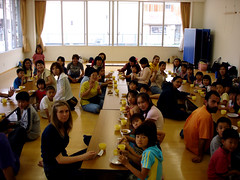
When we went back to the koinobori room there were a disconcerting amount of unexpected children sitting in two lines. What were they doing there? We were immediately instructed form a line in the middle of the children and then someone stood up and we had to play Japanese children games like count to ten in a weird way with your hands. Patronising perhaps, but the most fun I’ve ever had in a state of complete shock. We then had to get up and introduce ourselves, everyone except us Brits used Japanese. I really was going to, really bloody proper good Japanese but I was still in such a hyperactive place from counting, it sort of dismantled when it the thought hit my tongue. I said some things that were funny… if you could understand English.

See This
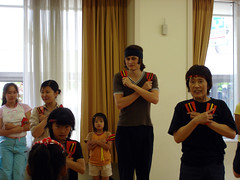
Then completely strangely some dancers came out – all older women or younger girls – performing what I thought was a very ridiculous, almost pop-bandy type dance. I was not the only one trying to contain their laughter I assure you. Then humility made yet another appearance – we were all then handed some ‘clicky-clacky’ things and then asked to follow the steps, which were unsurprisingly harder than they looked. Oh well, it was all fun and incredibly funny. After making paper aeroplanes, talking some more, and feeling inadequate some more, we left for our ‘parents’ home.
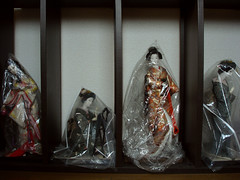
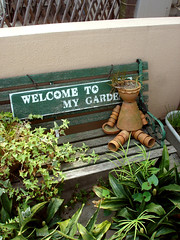
My family’s house was different from the others that surrounded it in that it looked like it was actually made out of brick. This of course was just a façade to make the house look more Western, a light tap confirmed the plasticy origins of the building material. The house its self was a satisfyingly kooky mix of West and East. You had the tatami room, the Japanese ornaments, and the general wooden cleanliness, mixed with high ceilings, big tables, and (the piste de resistance) a prim and proper English garden.
When I met Otoosan (‘father’) he was very nervous, I think due to him not being able to speak a word of English. I apologised again and again for my poor Japanese but he still kept fiddling around, and kept very silent. Mrs Shimizu was a complete contrast to this and was busy chatting away and laughing infectiously. In the first ten minutes of sitting down together she had handed me a ukulele from their recent venture to Hawaii, to play. I explained that I have never even seen one of these in my life, but they both waited expectedly for the ‘Happy Birthday’ tune on the sheet music laid in front of me. After the failed ukulele experiment, the standard photo showing and polite talk, I talked about how Japan is such a safe country. Surprisingly, I got a very revealing answer, “Japan is changing…due to a small amount of foreign people coming here”. It is interesting though that the only faces that I see on the wide-spread ‘wanted posters’ are those of natives. Obviously I don’t want to believe what the Shimizu’s were saying, but I am near completely uninformed, so my mouth is shut.
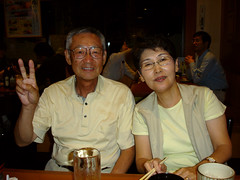
I went to a restaurant where I ate chips and bacon steak with just killed raw tuna and octopus (all eaten, of course, with chopsticks). I drank bier, sake, and ‘French’ wine. Otoosan got very drunk and all of a sudden he started, confidently speaking some English. I was not to know until it happened but I committed the ultimate Japanese faux pas – I offered to pay for my share of the bill. The Shimizus’ eyes burnt into my soul and filled it with stupidity and guilt.
We got back to the Shimizu house and Otoosan had to go to bed. Mrs Shimizu and I started talking and then she converted my name into Kanji. I was very proud with mine – ‘leader of samurai army’. Well I was proud until she started finding meaning in both my flatmates names – Harry and Pablo also, somehow, ended up being some kind of samurai commanders, admirals, or captains.
The next day we ate Eastern on Western style breakfast – fried egg, hotdogs, salad (with Japanese dressing), milk, and orange juice – naturally all eaten with chopsticks.
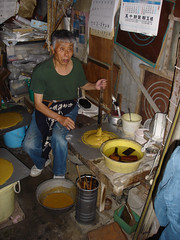
We then went to a big shed used for making koinobori. In the corner there was the koinobori master that we saw on news program excerpt from the previous day. Then the video cameras again started flooding in. On reading the newspaper cuttings scattered about the place it was said that ‘Koinobori Master’ was the third generation in his family to do this. A quote from him went something like this, “every year I make less Koinobori than the last, not because tradition is dying out, but because people are having less and less children”. From this I gather that Koinobori are made after a child is born for good luck, and that Japan perhaps is in decline.
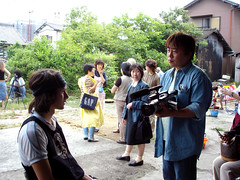
To wrap this up – I painted, I talked, I insulted Mrs Shimizu again by offering to pay for lunch (I swear someone asked me to), I was then interviewed for T.V. The weather was amazing and I had an ‘amazing’ time.
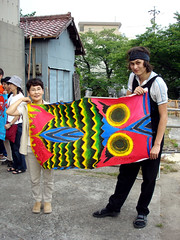
Before I went on this ‘homestay’ experience I was more than slightly apprehensive, no perhaps not ‘apprehensive’, more utterly cynical. I thought it was going to be a rope-hangingly painful, long drawn out affair, with too much polite conversation to handle, and I would have to feign tiredness to be allowed to retreat into the relative comfort of just me and my mind. Again my cynicism deserves to be shackled to a dark corner.
Within the first two minutes of the ‘experience’ beginning I was nearly in tears of laughter. My ‘mother’, Mrs Yoko Shimizu showed me the house that I would be staying in that night – it was two minutes walk from my flat. In fact it was so close the main object in view from the back garden was my block of flats. Anyway, we were driven to a hall somewhere close by for the weekends’ event – drawing and painting traditional Japanese Koinobori (koi-carp streamers and floats). The hall was full of foreign, sorry ‘international’, people – Mexicans, New Zealanders, a Russian, a Korean, an American, an Indonesian, and us Brits – this was to be expected; however, what was not expected at all, were the abundance of professional photographers and cameramen constantly invading personal space. We now knew that this day was going to be a lot weirder than your average. The shy looking Indonesian girl was thrust upon us simply because she spoke English, we had an awkward conversation and I did my favourite trick of running away. We were shown a video of a news broadcast of a koinobori master floating his creations, then we were given a demonstration on how to make a ‘traditional koinobori’. My immediate reaction to lessons and demonstrations is be completely childish and break all the rules and do what they don’t want to be ‘arty’, ‘original’, and ‘convention defying’. We then saw pictures of last year’s participants and one of the foreign painters appeared to be creating something radical and ‘challenging’, but then he only appeared very faintly in one photo, and then the group photo he was shunned to the back. We read too much into this and decided to keep to the conventions and actually learn something for fear of being erased from public memory.
There seemed to actually be some kind of pressure whilst drawing the koinobori because ‘mother’ seemed to always be watching me and taking photographs, and there were a multitude of other cameras snapping around the place. The Indonesian girl just happened to be sitting next to both me and Amelia, and so, you know, out of politeness I thought should say something, so I did. Then it turned out that she could speak fluent English, has led a lot more interesting life than me, her name is Sylvia, and was less of a girl and more of a woman (twenty seven). Few things humble me more than my own ignorance and stupidity.
For lunch whilst everyone else ate pre-packaged food, I ate delicious Japanese rice balls, and pickles, and fish sausage, and pepper – all lovingly prepared by Mrs Shimizu, my ‘mother’. I found out that Sylvia could actually speak Indonesian, Chinese, English and her Japanese was amazing after only two months, and she’s already majored in accountancy. What do I do with my life? Write this thing full of embellished, concisified nonsense, thinking that one day, one day, just maybe I can make a life out of this.

When we went back to the koinobori room there were a disconcerting amount of unexpected children sitting in two lines. What were they doing there? We were immediately instructed form a line in the middle of the children and then someone stood up and we had to play Japanese children games like count to ten in a weird way with your hands. Patronising perhaps, but the most fun I’ve ever had in a state of complete shock. We then had to get up and introduce ourselves, everyone except us Brits used Japanese. I really was going to, really bloody proper good Japanese but I was still in such a hyperactive place from counting, it sort of dismantled when it the thought hit my tongue. I said some things that were funny… if you could understand English.

See This

Then completely strangely some dancers came out – all older women or younger girls – performing what I thought was a very ridiculous, almost pop-bandy type dance. I was not the only one trying to contain their laughter I assure you. Then humility made yet another appearance – we were all then handed some ‘clicky-clacky’ things and then asked to follow the steps, which were unsurprisingly harder than they looked. Oh well, it was all fun and incredibly funny. After making paper aeroplanes, talking some more, and feeling inadequate some more, we left for our ‘parents’ home.


My family’s house was different from the others that surrounded it in that it looked like it was actually made out of brick. This of course was just a façade to make the house look more Western, a light tap confirmed the plasticy origins of the building material. The house its self was a satisfyingly kooky mix of West and East. You had the tatami room, the Japanese ornaments, and the general wooden cleanliness, mixed with high ceilings, big tables, and (the piste de resistance) a prim and proper English garden.
When I met Otoosan (‘father’) he was very nervous, I think due to him not being able to speak a word of English. I apologised again and again for my poor Japanese but he still kept fiddling around, and kept very silent. Mrs Shimizu was a complete contrast to this and was busy chatting away and laughing infectiously. In the first ten minutes of sitting down together she had handed me a ukulele from their recent venture to Hawaii, to play. I explained that I have never even seen one of these in my life, but they both waited expectedly for the ‘Happy Birthday’ tune on the sheet music laid in front of me. After the failed ukulele experiment, the standard photo showing and polite talk, I talked about how Japan is such a safe country. Surprisingly, I got a very revealing answer, “Japan is changing…due to a small amount of foreign people coming here”. It is interesting though that the only faces that I see on the wide-spread ‘wanted posters’ are those of natives. Obviously I don’t want to believe what the Shimizu’s were saying, but I am near completely uninformed, so my mouth is shut.

I went to a restaurant where I ate chips and bacon steak with just killed raw tuna and octopus (all eaten, of course, with chopsticks). I drank bier, sake, and ‘French’ wine. Otoosan got very drunk and all of a sudden he started, confidently speaking some English. I was not to know until it happened but I committed the ultimate Japanese faux pas – I offered to pay for my share of the bill. The Shimizus’ eyes burnt into my soul and filled it with stupidity and guilt.
We got back to the Shimizu house and Otoosan had to go to bed. Mrs Shimizu and I started talking and then she converted my name into Kanji. I was very proud with mine – ‘leader of samurai army’. Well I was proud until she started finding meaning in both my flatmates names – Harry and Pablo also, somehow, ended up being some kind of samurai commanders, admirals, or captains.
The next day we ate Eastern on Western style breakfast – fried egg, hotdogs, salad (with Japanese dressing), milk, and orange juice – naturally all eaten with chopsticks.

We then went to a big shed used for making koinobori. In the corner there was the koinobori master that we saw on news program excerpt from the previous day. Then the video cameras again started flooding in. On reading the newspaper cuttings scattered about the place it was said that ‘Koinobori Master’ was the third generation in his family to do this. A quote from him went something like this, “every year I make less Koinobori than the last, not because tradition is dying out, but because people are having less and less children”. From this I gather that Koinobori are made after a child is born for good luck, and that Japan perhaps is in decline.

To wrap this up – I painted, I talked, I insulted Mrs Shimizu again by offering to pay for lunch (I swear someone asked me to), I was then interviewed for T.V. The weather was amazing and I had an ‘amazing’ time.

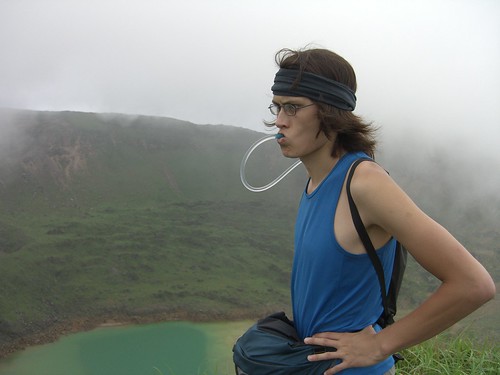
<< Home